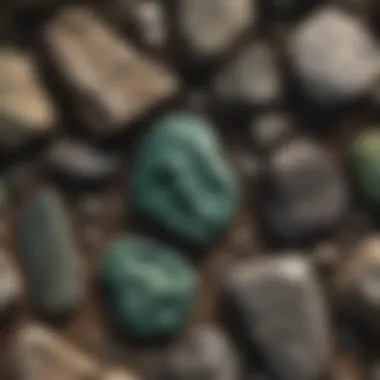Green and Black Stone Identification Guide


Intro
Green and black stones encompass various types of minerals and rocks, each with unique characteristics. For hobbyists and collectors, identifying these stones can be an enriching experience. Understanding the history and origins of these rocks adds value to their collection and enhances appreciation. In this guide, we will explore their significance, guide you through identification and classification and provide insights into their various uses and cultural impacts.
History and Origins
Overview of Collectibles, Rocks, and Fossils
The fascination with stones dates back thousands of years. From the ancient civilizations that built monuments to the modern collectors who appreciate their beauty, stones have always intrigued humanity. Green and black stones, in particular, have been used in jewelry, tools, and as artistic elements. Collectibles such as jade, basalt, and obsidian represent a small fraction of what exists. Each piece tells a story of Earth’s geological history.
Historical Significance and Cultural Impact
Throughout history, green and black stones have held specific meanings for different cultures. Jade, revered in Chinese culture, symbolizes purity and is associated with wisdom and strength. Similarly, the glossy finish of black obsidian has made it a popular choice for tools and decorative pieces among ancient peoples. These stones served not only practical purposes but also symbolized status and spirituality, making them essential in various rituals. Collectors today seek these stones not just for their physical properties, but also for their historical narratives.
Identification and Classification
Guide to Identifying Rocks and Fossils
Identifying green and black stones requires an understanding of their physical properties. Pay attention to color, texture, and hardness. Use tools such as a Mohs hardness scale for testing. Several key traits can aid in identification:
- Color: Varies from deep emerald to muted green, or from jet black to dark grey.
- Luster: Can be glassy, dull, or waxy depending on the mineral composition.
- Texture: Rough or smooth; sometimes, patterns like swirls or speckles appear.
Common Types and Variations
Within the realm of green and black stones, several types are prevalent:
- Jade: A green stone often used in carvings and jewelry.
- Malachite: Characterized by its distinct banding and rich green hue.
- Obsidian: A volcanic glass that is typically black and known for its sharp edges.
- Serpentine: A softer green stone frequently used in carving.
Understanding these variations is crucial for enthusiasts looking to properly classify their finds. Recognizing the subtle differences helps build a more comprehensive collection.
By exploring the origins of these stones and learning how to identify them effectively, collectors can enhance their knowledge and appreciation of these geological wonders. In the next sections, we will further delve into the characteristics and uses of these remarkable stones.
Intro to Stone Identification
Identifying stones is not merely a hobby; it represents a substantial field of study within geology and mineralogy. Understanding how to recognize and classify different types of stones is essential for both enthusiasts and collectors. Knowledge in this area provides insights into the natural world, enriches appreciation for geology, and enhances practical applications in various industries.
Importance of Stone Identification
Stone identification serves multiple purposes. First and foremost, it enables enthusiasts to properly categorize the specimens they collect. This classification assists in understanding the geological history and formation processes that led to the existence of each stone. For collectors, knowing the exact type of stone enhances the value of their collection. Furthermore, accurately identifying stones can lead to more informed decisions regarding their use in jewelry, construction, and other applications.
Additionally, stone identification helps cultivate awareness about conservation. By understanding where these stones come from and their environmental significance, collectors can contribute to sustainable practices in geology and mineralogy. This knowledge fosters a respect for the natural surroundings and promotes ethical collecting methods.
Basics of Mineral Classification
Mineral classification forms the foundation of stone identification. It involves grouping minerals based on their physical and chemical properties, which helps in recognizing different types identified through particular characteristics. Two primary systems are utilized: the classification by composition and the classification by occurrence.
In terms of composition, minerals are often categorized based on their dominant elements, such as silicates, carbonates, and oxides, among others. Each category reveals specific traits that help in distinguishing between various stones.
On the other hand, the classification based on occurrence focuses on the environmental conditions under which minerals forms. This includes igneous, metamorphic, and sedimentary processes. Understanding these classifications enhances the ability to recognize and differentiate among stones.
By grasping the basics of mineral classification, collectors can approach their study of stones with confidence. This framework not only aids in identification but also deepens the appreciation of the geological processes that create these remarkable natural resources.
Green Stones Overview
The exploration of green stones holds significant importance in the context of geology and mineralogy. Green stones have a unique aesthetic appeal and various applications in jewelry, construction, and ornamentation. Understanding their characteristics can greatly assist stone collectors and enthusiasts in making informed decisions. This section will delve into the types of green stones, their physical properties, and their geological formation processes.
Common Types of Green Stones
Jade
Jade is highly esteemed for its beauty and cultural significance. This stone is often linked to good luck and prosperity in various cultures. The key characteristic of jade is its range of green hues, from pale mint to deep emerald. Its toughness makes it a favored choice for carving intricate sculptures and jewelry.
One unique feature of jade is its two distinct mineral forms: jadeite and nephrite. Jadeite is rarer and more valuable, while nephrite is more commonly found. The downside of jade is that it can be difficult to distinguish from simila-like stones, which may mislead collectors.
Malachite
Malachite is another striking green stone, recognized for its vivid color and unique banding patterns. It is often used in decorative items and jewelry. The primary characteristic of malachite is its rich green color, which can range from light green to a very dark, almost black hue in certain parts.
The distinctive banding is a unique feature that contributes to its allure. Malachite is relatively soft compared to other stones, which means it can be prone to scratching and requires careful handling in jewelry design.
Emerald
Emeralds are one of the most sought-after green gemstones, celebrated for their striking color and rarity. Their primary characteristic is the vibrant green color, caused by trace amounts of chromium and vanadium. This makes emeralds a valuable addition to any gemstone collection.
Emeralds can contain inclusions, often referred to as "jardin," which can enhance their character. However, these inclusions may also detract from their value. The rich history and strong market demand for emeralds make them a beneficial focal point for anyone studying green stones.
Physical Properties of Green Stones
Color Variations
Color variations in green stones can greatly affect their identification and classifications. Green stones can exhibit a range of shades, from bright lime to muted olive, providing essential clues for collectors. The depth and intensity of color in green stones can lead to different valuation within the market.
Notably, variations can also indicate geological origin and potential treatments, which are crucial aspects for collectors to consider. An advantage is understanding these nuances can aid in the authentication process, whereas the downside is that it may complicate straightforward identification.
Texture Considerations
Texture plays a vital role in identifying green stones. This includes the feel and appearance of the surface and the stone's internal structure. Different stones have varying textures, from the smooth surface of jade to the layered appearance of malachite.


A key consideration for collectors is to examine these textural qualities, as they directly correlate to the stone's type. The disadvantage might be that stones can be polished, altering the natural texture and perhaps misleading identification.
Transparency and Luster
The transparency and luster of green stones provide further insights into their identification. Some green stones, like jade, may appear opaque, while others like emeralds, typically exhibit transparency and brilliance.
The luster is also a crucial identifier; jade has a waxy, sometimes greasy luster, while emeralds have a glassy appearance. This understanding is beneficial as it can assist in classification. However, variations in treatment can affect these properties, leading to potential misidentifications.
Geological Formation of Green Stones
Igneous Processes
Green stones often originate from igneous processes, which involve the cooling and solidification of magma or lava. This geological formation contributes to the richness of the green hue in some stones, particularly jadeite.
This characteristic allows collectors to trace the stone's origin, creating a significant value in learning about the formation process. The downside is that not all green stones will show clear igneous traits, which complicates identification.
Metamorphic Transformations
Many green stones, such as emeralds, are formed through metamorphic processes. The conditions of heat and pressure transform simpler minerals into more complex green stones. Understanding these transformations is critical for collectors who wish to appreciate the journey of these stones.
A unique aspect is that the metamorphic environment can greatly influence the stone's final appearance, including color saturation. However, these transformations may also obscure the original properties, making it challenging to identify stones accurately.
Sedimentary Occurrences
Some green stones are found within sedimentary deposits, resulting from the accumulation of mineral-rich sediments over time. This formation contributes to a distinct geological narrative that can be intriguing for collectors.
The presence of minerals in sedimentary rocks might indicate environmental conditions. Recognizing these signs can be beneficial for potential collectors. However, stones from sedimentary origins might often lack the vibrant color variation seen in igneous and metamorphic stones, which could detract from some collectors' interest.
Black Stones Overview
Black stones represent a fascinating realm in the world of geology and mineralogy. Understanding these stones provides insights into their origins, characteristics, and utilization. Their distinct appearance and unique properties make black stones a vital area of study for both hobbyists and professionals. Identifying black stones enhances one's capacity to appreciate the intricate processes that shape our planet. Moreover, knowledge of these stones can contribute to successful collection practices and proper usage in various applications.
Common Types of Black Stones
Obsidian
Obsidian is a volcanic glass formed from rapidly cooled lava. This stone is highly valued for its smooth texture and shiny surface. Its natural glassy sheen gives it a distinctive look, making it popular in jewelry and decorative items. Besides aesthetics, obsidian has a historical significance. Ancient cultures used it for making tools and weapons due to its sharp edges. The clearness of obsidian can vary, showcasing various designs. While it is easily shaped, it can also be brittle, which may lead to breakage if not handled with care.
Basalt
Basalt is an igneous rock often found in oceanic crust and volcanic islands. This stone is dense and commonly used in construction and landscaping. The key characteristic of basalt is its ability to withstand weathering, making it an excellent material for long-lasting structures. Basalt is typically black or dark gray, offering an appealing aesthetic for those focused on durable design. However, its high density also means that it can be heavy, influencing transportation and handling needs.
Jet
Jet is an organic gemstone formed from decomposed wood under extreme pressure. Its rich black color and smooth finish make it a popular choice for jewelry. Jet has been used since ancient times, valued both for its beauty and historical significance. A unique feature of jet is its lightweight nature, which provides comfort when worn. Despite its attractiveness, jet can be sensitive to heat and harsh chemicals, which may limit its applicable uses.
Physical Properties of Black Stones
Color Depth
Color depth in black stones can vary significantly, showcasing the vast diversity within this category. A particular characteristic of black stones is their ability to exhibit various shades of black, from deep matte to shiny surfaces. This variation can affect their desirability and valuation in collections and markets alike. While deeper colors often signify higher quality, some collectors may appreciate lesser shades for their uniqueness.
Surface Characteristics
Surface characteristics define the tactile element of black stones. These can include textures ranging from smooth to rough. The interest in surface types lies in their influence on the stone's visual appeal and handling properties. For instance, polished stones are often favored in jewelry, while rough surfaces may appeal to collectors looking for natural specimens. Each type offers benefits and drawbacks, depending on intended use and aesthetic preference.
Weight and Density
Weight and density are crucial aspects when evaluating black stones. Heavier stones signify higher density and can be indicative of their mineral composition. This characteristic serves as a functional consideration, especially for collectors looking to use stones in construction or jewelry. Lighter stones may be easier to handle, but this could reflect lesser durability. Knowing these properties aids collectors in making informed choices based on their particular needs.
Geological Formation of Black Stones
Volcanic Formation
Volcanic formation primarily contributes to the existence of many black stones, notably obsidian and basalt. This process involves magma cooling rapidly, leading to solidification. The rapid cooling accounts for the glassy texture of obsidian and the dense structure of basalt. Understanding volcanic origins can aid collectors in locating these stones in nature, enhancing their collecting experience.
Metamorphic Series
Metamorphic processes can transform existing stones into different types of black stones through extreme heat and pressure. The metamorphic series explains how minerals can change, influencing their final appearance and properties. This aspect can be crucial for collectors aiming to study geological formations and processes that create diverse stone types.
Organic Origins
Organic origins differentiate certain black stones like jet from purely mineral-based counterparts. The unique formation process involves organic material, primarily wood, undergoing transformation due to pressure over time. This distinct origin makes it noteworthy for collectors and helps understand the broader narrative behind black stones' formation. However, its fragility under certain conditions may limit its usability compared to more rigid stones.
Identification Techniques
The identification techniques form a crucial aspect of stone classification. Precise methods enable collectors and geologists to differentiate between various green and black stones effectively. These techniques can often reveal insights into the geological history of the stones as well as their potential uses. Mastering these methods can enhance one’s appreciation for these natural gems, making the identification process both informative and enjoyable.
Visual Inspection Methods
Visual inspection is the first step in stone identification. It allows for a broad understanding before more detailed analysis occurs. Collectors use their eyesight to assess several features that provide clues regarding the stone's identity.
Color Consistency
Color consistency is the uniformity of the stone's hue across its surface. This aspect plays an important role in identifying stones. It can indicate the mineral content and purity of the stone. A consistent color is typically a sign of high quality, especially in stones like jade or emerald.
Key Characteristics
The uniqueness of color consistency lies in its simplicity. Observing color patterns gives initial insight into potential classifications. Many collectors find this aspect beneficial as it is easy to assess.


Advantages and Disadvantages
One advantage is that color consistency is usually visible without special equipment. However, some stones may have similar colors, leading to confusion. Careful observation is key to making accurate identifications.
Surface Patterns
Surface patterns include any textural or structural details visible on a stone. This can reflect the stone’s formation and history. Patterns created during mineral growth can provide important clues.
Key Characteristics
Patterns can vary greatly, creating distinctive looks. This uniqueness helps in closely identifying specific stones. The presence of specific patterns often indicates certain types of stones, such as malachite or obsidian.
Advantages and Disadvantages
Patterns must be closely observed for accurate identification. The challenge lies in recognizing subtle distinctions. Not all stones will exhibit noticeable patterns, which may hinder identification.
Intrusive Features
Intrusive features refer to characteristics that interrupt the surface continuity of the stone. This could include pockets, veins, or inclusions. These features can often lead to a more precise identification of the stone type.
Key Characteristics
Intrusive features provide clues about how a stone was formed and the conditions present during its formation. They offer insight into its geological background. Many collectors value this information as it can enhance the narrative of the stone’s origin.
Advantages and Disadvantages
While intrusive features can aid identification, they may also complicate it. When features are overly subtle, they can be missed. Consistent training in observation techniques is essential for effective use.
Textural Analysis
Textural analysis involves examining the physical structure and feel of a stone. This method complements visual inspections by evaluating dimensions and material composition.
Grain Size Evaluation
Grain size evaluation assesses the size of individual mineral particles in a stone. This aspect significantly impacts the stone's appearance and qualities. Smaller grains often suggest a finer texture which is valued in certain stones.
Key Characteristics
Different minerals display distinct grain sizes, contributing to their identification. A collector can learn much about a stone from this single characteristic. Fine-grained textures are often more desirable for gemstones due to their appearance.
Advantages and Disadvantages
Grain size can easily be assessed by touch or sight. However, some stones may not show clear distinctions, complicating identification. Knowledge of average grain sizes for various stones can improve accuracy.
Foliation Assessment
Foliation is the layering or banding seen in certain rocks. This is typically a product of metamorphic processes. Assessing foliation can help distinguish between similar stone types.
Key Characteristics
The presence of foliation can often point to specific mineral compositions, guiding identification. It can reveal the conditions under which the stone formed. Many collectors find this aspect fascinating, especially when identifying metamorphic stones.
Advantages and Disadvantages
Foliation is a clear indicator in many cases. However, not all rocks exhibit foliation patterns. This can make it challenging to use in the identification process occasionally.
Chemical Tests for Identification
Chemical tests provide a more scientific means of identifying stones. They involve reactions with various substances. While a bit more advanced, these tests can yield definitive results.
Acid Tests
Acid tests involve applying a dilute acid to the stone to observe reactions. Certain minerals react noticeably; this helps in identification. For example, calcite will fizz when it comes in contact with hydrochloric acid.
Key Characteristics
This method is direct and can result in clear information about the mineral makeup. It is a relatively reliable choice for anyone serious about stone identification.
Advantages and Disadvantages
The main advantage is the clarity of results. However, this method requires caution to avoid damaging the stone. Not all stones will react, limiting this method’s use.
Streak Plate Method
The streak plate method examines the color of a mineral in powdered form. A soft stone can leave a streak on a ceramic plate. This simple test is informative and easy to conduct.
Key Characteristics
It reveals the mineral’s true color, often different from the color seen in larger specimens. Many collectors use this method for quick identifications.
Advantages and Disadvantages
This method is quick and easy to apply, and it does not require extensive training. However, not all stones can be tested this way, as harder stones may not leave a streak at all.
Comparative Analysis of Green and Black Stones
The comparative analysis of green and black stones serves as a critical aspect of understanding geological diversity. By differing in mineral composition, the examination of these stones helps enthusiasts and collectors distinguish between them. This section will outline the key differences in composition, geological significance, and how these factors influence identification. Understanding these distinctions can aid in appreciation and practical applications for both green and black stones.
Key Differences in Composition
Elemental Makeup
The elemental makeup of stones refers to the specific minerals that constitute each type.
Green stones often contain silicon (Si), aluminum (Al), and iron (Fe), which manifest in a variety of shades, primarily driven by iron's oxidation states. This characteristic makes green stones appealing for both aesthetic and scientific purposes. Their chemical composition has implications for their physical properties, influencing hardness, color, and patterns.
Black stones, on the other hand, frequently include higher amounts of magnesium (Mg) and silicon (Si), contributing to their deeper hues. These stones are usually denser than green stones and have different durability factors, making them suitable for specific applications.
The uniqueness of elemental composition is vital for accurate identification. Therefore, understanding the intricacies of each type will enhance the collector’s ability to classify effectively.
Mineral Pairings
Mineral pairings provide insight into the interrelationships between different minerals present in the stones. Green stones frequently showcase pairings like nephrite and actinolite, which create durable and aesthetically pleasing combinations, often used in carvings and jewelry. This characteristic not only enriches their visual appeal but also enhances their market value.
Conversely, black stones typically feature pairings such as graphite and pyrite. These combinations can lead to distinctive physical properties and patterns, helping collectors delineate one stone from another quickly.
The understanding of mineral pairings is essential for collectors, as it impacts valuation and application in practical scenarios. They may choose to invest in certain combinations for their rarity or aesthetic qualities.
Contrasting Geological Significance
Understanding the geological significance of each stone type involves appreciating their formation conditions and distribution patterns.
Formation Conditions


The formation conditions of stones provide crucial insights into their origins. Green stones tend to form under specific metamorphic conditions, where pressures and temperatures influence their development. For example, jade can form from the alteration of specific mineral-rich rocks under high pressure.
In contrast, black stones are often related to volcanic activity, created from the cooling of lava or magma. Each type’s unique environmental conditions can affect not only aesthetic qualities but also utility in construction and jewelry-making. Knowing these aspects gives the collector a more profound understanding of each type's history and significance.
Distribution Patterns
The distribution patterns of green and black stones reveal their abundance and accessibility in various geological contexts. Green stones, such as emeralds and jade, are often found in sedimentary and metamorphic deposits in specific regions around the world, such as Colombia or Myanmar. This geographic specificity can influence not only collection practices but also market trends.
In contrast, black stones like basalt are widespread and can be found in igneous regions globally, from Iceland to Hawaii. Their broad distribution often makes them more accessible to collectors. This information shapes the collector's approach in sourcing and acquiring stones for both personal collections and investments.
Understanding these differences is essential for enthusiasts who seek to accurately identify and appreciate the value of their specimens.
Practical Applications of Green and Black Stones
Understanding the practical applications of green and black stones is crucial for a well-rounded appreciation of these geological resources. Not only are they valued for their beauty, but they also possess significant functional properties that serve various industries and artistic fields. This duality is what makes these stones so relevant in both commercial and creative contexts. Their unique characteristics allow them to be utilized in multiple ways, enhancing the value they bring to jewelry crafting, construction, and even industrial applications.
Uses in Jewelry and Decorative Arts
Green and black stones have been prized for centuries in jewelry and decorative arts. Their vibrant colors and various textures contribute to the aesthetic appeal in handcrafted items. Common green stones like jade and emerald add a touch of luxury and sophistication, while black stones like jet infuse an air of elegance and mystery.
In the jewelry world, durability is paramount. These stones offer not just beauty but also strength, making them suitable for daily wear. For instance, the toughness of jade ensures it resists chipping and fading, allowing it to maintain its luster over time. Black stones can also serve as dramatic focal points in designs, particularly due to their high contrast with lighter materials. This versatility makes these stones significant for both traditional and contemporary jewelry designers, resulting in a rich assortment of options for collectors and consumers alike.
Industrial Applications
Construction Materials
Green and black stones play a pivotal role in the construction industry. Their inherent strength and varying textures provide not only aesthetic value but also structural integrity. For instance, basalt is renowned for its durability and is often used in building foundations and road construction. This material's resistance to weathering makes it a common choice for projects that demand longevity. Furthermore, the thermal properties of certain stones can enhance the energy efficiency of structures, making them a practical option.
However, there are challenges associated with using these stones in construction. For example, sourcing these materials can be restrictive due to location and availability. Additionally, differences in performance based on stone type and treatment might influence the decision-making of builders. Despite this, the benefits often outweigh the concerns, solidifying the role of green and black stones in the robust construction industry.
Abrasives and Cutting Tools
In industrial settings, the application of green and black stones extends to abrasives and cutting tools. These materials often exhibit exceptional hardness, making them ideal for cutting and grinding processes. For example, diamond-tipped tools, which can incorporate black stones like basalt, are popular for their efficiency in slicing through dense materials. Their effectiveness enhances productivity in manufacturing and craftsmanship sectors, proving beneficial to businesses that rely on precision.
However, careful selection is essential as not all stones share identical performance characteristics. Some may exhibit abrasive wear more quickly compared to others, affecting their longevity in jobs requiring extensive use. Ultimately, the right balance between tool material and intended application is crucial for achieving optimal results.
"Understanding stone’s characteristics can greatly enhance its practical usability in various sectors."
In summary, the practical applications of green and black stones span a wide range of fields from jewelry to construction and industrial tools. Their diverse properties reveal their impact and importance, underscoring the need for enthusiasts and collectors to recognize their value beyond mere aesthetics.
Challenges in Stone Identification
Identifying stones can be a complex process. The challenges arise from various factors that influence the properties and characteristics of stones. Understanding these challenges is vital for anyone interested in geology or mineralogy. By recognizing these obstacles, collectors can enhance their ability to accurately identify and appreciate different types of stones.
Environmental Factors
Weathering Effects
Weathering effects play a significant role in stone identification. Over time, stones undergo changes due to exposure to elements like wind, rain, and temperature fluctuations. This natural process can alter a stone's appearance, making it harder to identify. For example, a green stone may lose its vibrant hue or develop a crust due to weather exposure.
The key characteristic of weathering is that it reveals the resilience and adaptability of stones in different environments. This aspect is essential for the understanding of how stones can change over time. Although the weathering effects can confuse identification, they also offer insights into the stone's history and origin. The advantage of recognizing these changes is that one can appreciate the stone's life cycle, which adds depth to the collecting experience.
Location Variability
Location variability is another crucial element in stone identification. Different geographical regions have distinct characteristics that influence the types of stones found there. A collector may notice that a stone from a volcanic region may differ in composition and texture from one located in sedimentary basins.
The unique feature of location variability lies in its role as a contextual clue when identifying stones. It adds another layer of consideration for collectors. Understanding the location of a stone can provide vital information about its formation and possible mineral content. This knowledge can help in determining authenticity, which is a major advantage for serious collectors. However, relying solely on location can also present disadvantages, as stones might be transported, making their original context unclear.
Human Influence on Identification
Artificial Treatments
Artificial treatments of stones can significantly affect identification. Many stones are treated to enhance their color or appearance before they enter the market. Techniques such as dyeing, heating, or resin impregnation are common practices. While these treatments can make a stone more visually appealing, they complicate the identification process.
The key characteristic of artificial treatments is their capacity to alter a stone's natural state. This alteration can mislead collectors who are not aware of the treatments. Sometimes, these modifications can make a stone appear more valuable than it is. A collector's challenge is to discern between naturally beautiful stones and those that have been artificially enhanced. The downfall of relying on visual appeal is that it can lead to misguided investment, should the origin of the treatment be overlooked.
Ethical and Legal Considerations
Ethical and legal considerations are vital aspects in the process of stone identification. Collectors must be aware of regulations regarding the collection of stones in various regions. Some stones may be protected due to their rarity or cultural significance. Ignoring these considerations could lead to legal consequences for collectors.
The critical aspect of ethical and legal factors is their role in promoting responsible collecting practices. Being informed about regulations encourages respect towards nature and cultural heritage. Failure to comply with legal standards could also harm the reputation of the collector and the wider community. However, navigating these rules can often be challenging, especially for newcomers. Therefore, additional research and learning are necessary to ensure ethical practices in stone identification.
Understanding the challenges in stone identification not only enhances a collector's skills but also promotes responsible collecting habits.
Epilogue and Future Directions
The field of stone identification, particularly concerning green and black stones, is of significant importance in both geology and mineralogy. Understanding these stones allows for deeper insights into the Earth’s processes and resources. In this concluding section, we summarize key findings and explore the future landscape of stone collecting and identification.
Summary of Key Insights
Throughout this guide, we have covered essential aspects of identifying and classifying green and black stones. Here are some vital insights:
- Characteristics: Each stone type has unique physical and chemical properties that aid in identification. Green stones often share traits such as transparency and texture variations, while black stones are known for their depth of color and density.
- Geological Formation: The processes forming these stones, such as volcanic activity or metamorphic events, play a crucial role in understanding where these stones might be found.
- Identification Techniques: Visual inspection, textural analysis, and chemical tests provide practical methods for enthusiasts to accurately identify stones.
Understanding these factors enhances one’s ability to appreciate the geological history and significance of these stones.
Emerging Trends in Stone Collecting
The world of stone collecting is undergoing various changes. New trends are emerging that reflect the evolving interests of collectors:
- Focus on Ethical Sourcing: As awareness of environmental and ethical issues increases, collectors are prioritizing stones sourced sustainably.
- Technological Integration: Advances in technology are allowing for better identification tools, such as apps that utilize artificial intelligence for stone recognition.
- Educational Resources: The rise of online forums and communities, such as those found on Reddit and Facebook, offers collectors platforms for sharing knowledge and experiences.
- Social Impact: Local stone markets and fairs are gaining popularity, fostering connections among collectors and supporting local economies.
The landscape of stone collecting and identification is rich with potential for growth and exploration. By staying informed about these trends, enthusiasts can actively engage with the evolving dynamics of this fascinating hobby.



